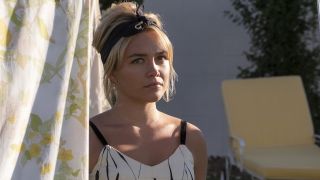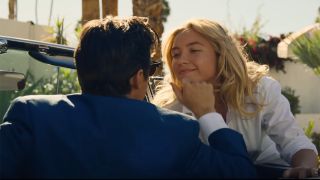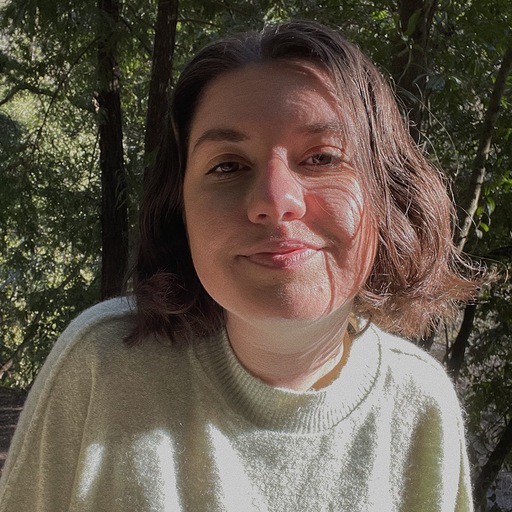Don't Worry Darling Originally Ended Much Differently, And That Finale Sounds Way Cooler
There could have been more to its big twist.

SPOILERS are ahead for Don’t Worry Darling. Check out Olivia Wilde's thriller, now playing in theaters, before reading on.
I don’t know about you, but I left the theater still quite worried about Florence Pugh’s Alice. After two hours of teases and hints at her actual fate in the peculiar 1950s town of Victory, not enough was answered. Sometimes a cliffhanger ending like Don’t Worry Darling is the right call, but I had so many questions and gripes with how the concept was handled that I was left feeling the movie’s mystery was more empty than satisfying. But when I read the original ending to Olivia Wilde’s alleged drama-filled movie, I became more disappointed. Via the initial script, Don't Worry Darling could have fixed a few of the problems I had with the movie’s fade to black. Let’s talk about it.
Don’t Worry Darling was originally written by brothers Carey and Shane Van Dyke before it was placed on the 2019 Black List, which is an annual survey of the “most-liked” screenplays that were not picked up by producers and studios to become movies. Olivia Wilde reportedly came across the script through the Black List and decided it would be her next film. Wilde’s Booksmart writer Katie Silberman then did a rewrite on the script, and among the changes were some big adjustments to the finale.

What Was The Original Don’t Worry Darling Ending?
In the original third act of Don’t Worry Darling, Alice, who is named Evelyn in the script, follows her husband Jack, played by Harry Styles, who's called Clifford in the script. As her suspicions grow about Victory, she watches him go into a house with a "For Sale" sign in front of it, and when she goes in and finds another sign called “Alt-Life Reality.” While she’s not able to get inside the house further, she goes into her husband’s car and finds his briefcase containing ads for the simulation she is in that reads “Successful marriages start in the kitchen!” alongside other sexist slogans and images, including lewd sexual drawings drawn by her husband. She then goes back to that "For Sale" house through a window where she finds herself in 2050, outside of the simulation.
It’s then Alice/Evelyn learns her husband is a Fry’s Electronics "Employee of the Month" and sees divorce papers addressed to their names. She goes on his computer in real life and learns that the Alt-Life Reality program is a “society of men, by men, and for men,” and watches a disturbing intro video where Chris Pine’s character further explains the twist of the movie. Apparently her husband had to fake her death in order to get her in the simulation. She then finds articles of her going missing, a police search for her and her loved ones mourning her once she is never found, all the while thinking she's a '50s housewife in her ex-husband's fantasy.
Alice/Evelyn then goes back into the simulation where she has a confrontation with Jack/Clifford before he realizes she’s escaped. She goes back to business as usual before making him an elaborate dinner and hitting him with a shovel and tying him to a bed. When he wakes, it’s then that we learn his intentions: “I wanted us to be happy again” after their failed marriage. The pair go into all their dirty laundry over the years. Alice/Evelyn goes back to 2050, but Jack/Clifford cuts himself free and follows her through the portal.
In 2050, the pair engage in a physical fight before she stabs him in the ribs with a kitchen knife. Then somehow Alice/Evelyn is back in the 1950s, snatched up by the Alt-Reality team, where Chris Pine’s character tries to convince her that it is reality and she’s gone insane. In the final scene, Alice/Evelyn is at a psychiatric ward when Olivia Wilde’s character Bunny (Betsy in the script) brings her flowers and whispers to her of a nearby portal, and they walk out together, finally free of Victory (hopefully).
CINEMABLEND NEWSLETTER
Your Daily Blend of Entertainment News

How It Compares To Olivia Wilde’s Movie
Here’s why I like the original ending better. For one, Alice finds her own way out of the simulation rather than being caught by her husband and taken away. It’s more of an active ending for our protagonist rather than her being thrust into learning of her fate. We also get to know more about the kind of man her husband is rather than what happened in the movie, which seems to somewhat underplay his decision to take her away from her normal life by only revealing it at the end and barely developing Jack’s character, along with many others. This includes Kiki Layne’s, who even shared she had “cut” scenes. I like the more gruesome details of him faking her death and Alice getting to see the exact images that inspired him to go into the simulation, including an introductory video for his Alt-Life Reality, which Chris Pine would have absolutely crushed. All this hits home the message of the film a lot better.
Additionally, I really like the idea of Olivia Wilde’s Bunny being the one who ultimately saves Alice after she is thrust back into the simulation. The original ending is a good one-two-three punch of a finale: one being learning about the simulation, two being placed back in the simulation under the guise she really was crazy, and three being one of the other women in the simulation listening to her cries for help earlier in the film and acting on them. It’s night and day compared to us basically learning the twist, then sitting with it and having a ton of questions in the fallout of the finale, all on top of whether there really were big tensions on the Don't Worry Darling set.
While some of the same beats are hit in the Don’t Worry Darling, the original script involved more attention to the twist after most of the movie had alluded to one without much focus placed on making it a satisfying ending. As CinemaBlend’s own review of Don’t Worry Darling suggested, it “drags far more than any thriller should,” which then makes the ending suffer when it doesn’t do enough to quench the thirst of solving the mystery we sat with for way too long.
In the original finale, it’s more fleshed out and there’s a lot more story on the other side of learning Victory is part of a simulation. Most importantly, Florence Pugh’s character and many others have more things to do and have more depth to them than 1950s dress-up.

Sarah El-Mahmoud has been with CinemaBlend since 2018 after graduating from Cal State Fullerton with a degree in Journalism. In college, she was the Managing Editor of the award-winning college paper, The Daily Titan, where she specialized in writing/editing long-form features, profiles and arts & entertainment coverage, including her first run-in with movie reporting, with a phone interview with Guillermo del Toro for Best Picture winner, The Shape of Water. Now she's into covering YA television and movies, and plenty of horror. Word webslinger. All her writing should be read in Sarah Connor’s Terminator 2 voice over.
